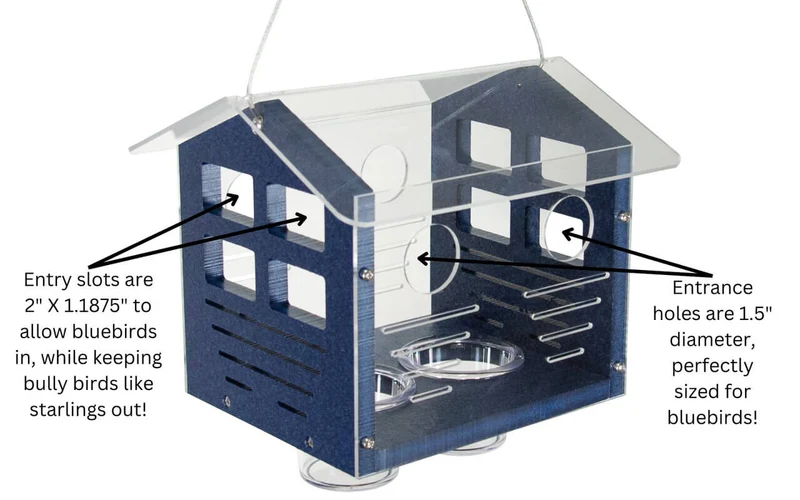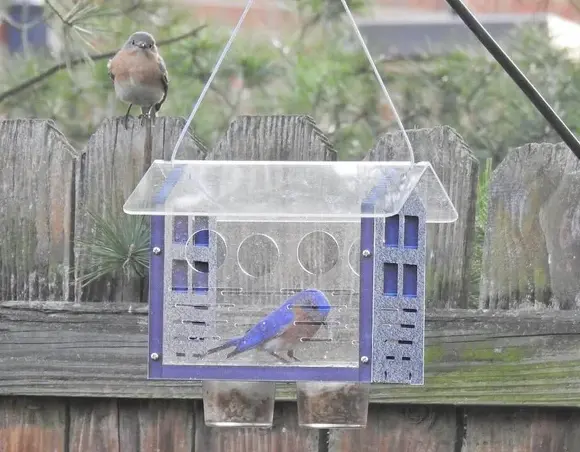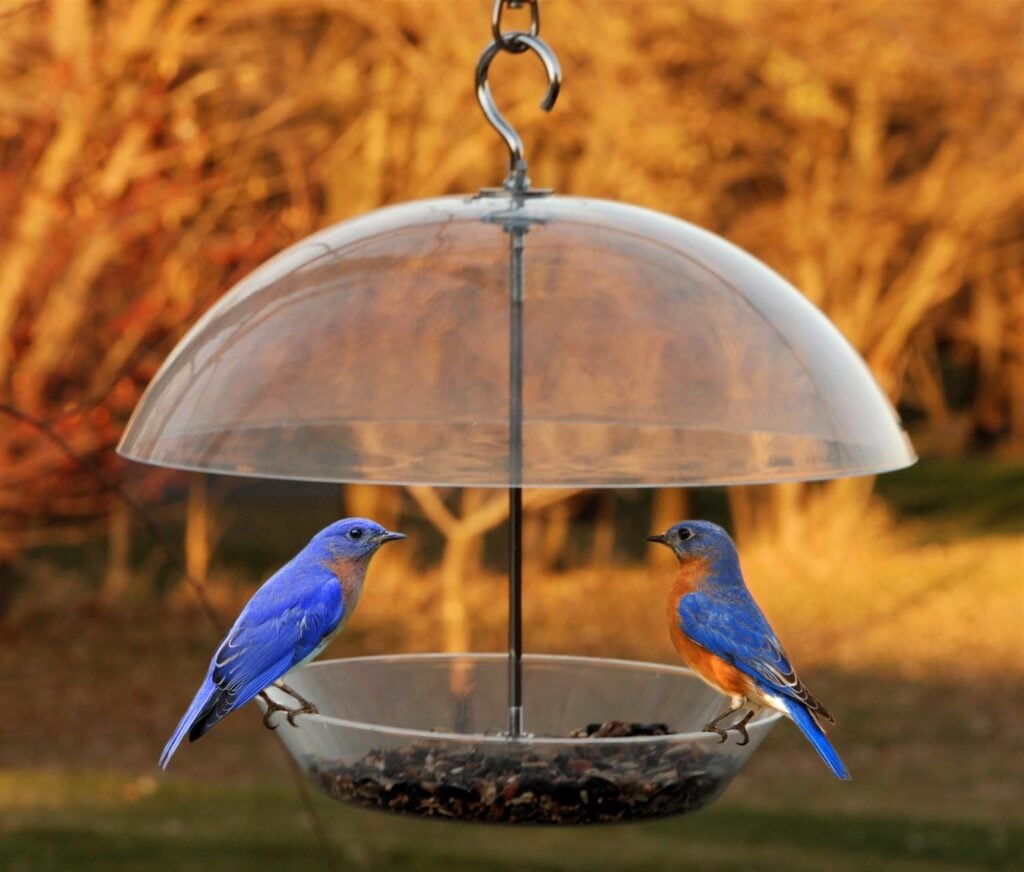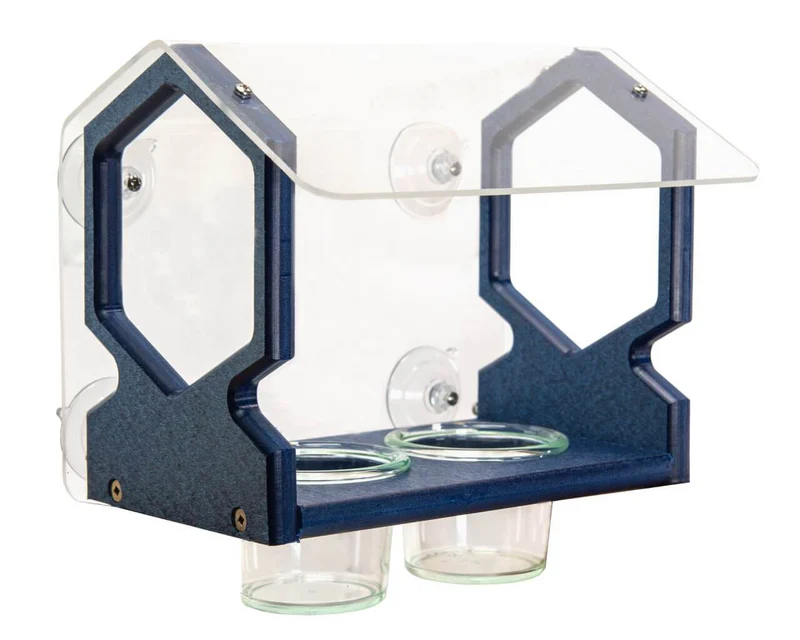The 5 BEST Bluebird Feeders To Try (Perfect for Mealworms)
What are the BEST bird feeders for bluebirds?

Unfortunately, getting bluebirds to come to your bird feeders can be challenging. The problem is that bluebirds rarely eat birdseed!
Instead, bluebirds LOVE eating mealworms!

Mealworms are the larvae of the darkling beetle (So technically they are not worms at all). They are easy to raise and commercially available as bird food, pet food, and fish bait.
The key to a successful bluebird feeder is providing a constant source of mealworms as food. You might as well call your bluebird feeder a mealworm feeder.
- RELATED: 6 Proven Ways to Attract BLUEBIRDS!
Below are 5 of the BEST bluebird feeders that are perfect for feeding mealworms!
- Make sure to scroll to the end to learn 5 tips for using mealworms in your feeder. Or click HERE to go straight there. 🙂
- IMPORTANT NOTE: Please realize that the below bluebird feeders are NOT only for bluebirds! By selecting a different type of food to place in the feeder (peanuts, corn, other various types of seed, etc.), they work equally well to attract other species.
#1. JCS Wildlife Enclosed Bluebird Feeder

View Today's Price – Save 10% automatically by clicking this link
Positives:
- This feeder is designed with bluebirds in mind! The only way to enter is through one of the twelve entry holes. Bluebirds can fit, but bigger birds that also enjoy mealworms, like starlings, can’t!
- Each sidewall is made of transparent and durable acrylic . This allows the bluebirds to find the mealworms AND lets us observe them while inside the feeder.
- The feeder is very well made. The durable eco-friendly recycled poly lumber provides solid construction.
- The roof of this feeder easily slides upward to refill the included mealworm cups and the attached hanging cable means easy mounting.

#2. Woodlink Domed Bluebird Feeder

Positives:
- The dome over the saucer/dish helps to keep the mealworms dry from the rain.
- If you prefer using live mealworms, they can’t escape! They won’t be able to climb up the smooth plastic sides of the bottom dish.
- Since everything is clear, it should be easy for the bluebirds to find the mealworms.
- The dome can be adjusted to go lower, which helps keep larger birds (such as pigeons) out!
- This bluebird feeder is made of durable polycarbonate, which means that it is very tough and resistant to cracking or breaking. No worries if this accidentally falls to the ground!
- Take a look at the picture. It’s a very SIMPLE design. I like simple. It’s easy to take apart to clean and dirt easily washes off from the smooth plastic.
#3. Stokes Snack ‘N’ Treats Bluebird Feeder

Positives:
- This feeder has a simple design. It’s a small dish (10 oz) that easily snaps in and out of place to clean and refill.
- Think of this bluebird feeder as a place to put small amounts of treats for various bird species. Obviously, mealworms work great for bluebirds, but you could also try jelly (for Orioles), suet nuggets, or other types of speciality seed.
- Live mealworms won’t be able to climb up the smooth polycarbonate walls.
- It has small slits in the sides which allow for proper draining. You should never have any standing water in this feeder.
- Extremely durable! It’s made out of hard plastic.
Negatives:
- This bluebird feeder is small. It’s perfect to put out mealworms as treats every day, but the food won’t last long. Don’t expect this feeder to feed many birds; it’s not designed for that.
- Because of the small dimensions, it does not allow many birds to perch at one time.
#4. Platform/Tray Bluebird Feeder

Currently, I am using my tray feeder on the ground underneath my bird feeding station to attract ground-feeding birds, squirrels, rabbits, raccoons, and opossums. To attract bluebirds, you would want to hang the platform from a tree or pole mount.
Check out the LIVE stream below to see my tray feeder!

Woodlink 3 in 1 Platform Feeder View Today's Price
Positives:
- This is an excellent, multi-purpose platform feeder. To attract bluebirds, just spread some mealworms on top. You can use different types of foods to attract other species.
- It’s solid and well constructed – made from cedar and screwed together well.
- The metal screen bottom provides excellent drainage. Your mealworms and food will never be sitting in standing water.
- The metal screen bottom is removable and slides right out, which makes it very easy to clean!
- The bluebird feeder is big and can hold lots of birds at one time. (16.4 x 13.2 x 2.4 inches)
Negatives:
- You won’t be able to use live mealworms in this feeder. They would crawl right out! You could place them in a dish inside the feeder, but only if this was sitting solidly on the ground or pole mounted.
#5: JCS Wildlife Geometric Window Bluebird Feeder

View Today's Price – Save 10% automatically by clicking this link
Positives:
- This bluebird feeder attaches directly to your window and gives a close-up view of your bluebirds! See every detail from the comfort of your living room couch. This is fun for ALL ages and a great way to get kids interested in birds.
- Window bird feeders are notoriously hard to keep attached, but I have had no problems with this one. It has four suction cups to help do the job. (Make sure to clean your window thoroughly without soap before securing)
- Live mealworms won’t be able to climb out of the plastic cups.
- The cups are removable. This makes it very simple to clean! No need to take the whole feeder inside to wash.
5 Tips When Feeding Mealworms to Bluebirds:
We have established that mealworms are the BEST food to attract bluebirds to your backyard bird feeders. I wanted to provide a few extra tips and insights that may be helpful when it comes to feeding mealworms to bluebirds.
Tip #1. Live mealworms will outperform dried mealworms.
This is an unfortunate fact because dried mealworms are much easier to buy and store. Keeping live mealworms is a bit more work since you must provide care to them. Some people also don’t like handling them and get a bit squeamish.
But you may have to use live mealworms in your feeders to initially get bluebirds to your yard. Bluebirds prefer living, juicy mealworms to their dried counterparts.
Pro Tip: To initially attract bluebirds to your backyard feeders, you may need to use a mix of live AND dried mealworms. Eating a live mealworm is much more natural for a bluebird, and they might have to be trained to eat the dried ones. By mixing them, they will accidentally eat the dried ones and realize they are also edible. From there they can be slowly transitioned to dried mealworms.
Tip #2. Only use mealworms to SUPPLEMENT a bluebird’s diet.
Once bluebirds start coming to your feeders, they can become incredibly addicting. As soon as they eat all the mealworms, you will want to run back out to refill to watch them again and again.

Please resist this temptation.
Mealworms don’t offer complete nutrition for a bluebird and can cause problems if this is the only food that they are eating. Specifically, mealworms don’t provide the needed calcium and can cause bone issues in young bluebirds.
Tip #3. Bluebirds may accept a few other foods other than mealworms.
This article has focused mainly on using mealworms at your bluebird feeders, but there are a few other foods they may accept and eat. You will have more luck with these foods during environmentally hard times for bluebirds, such as a harsh winter when there is nothing else to eat!
- Suet
- Softened raisins
- Sunflower hearts
Tip #4. Train your bluebirds!
Yes, it is possible!
Just be consistent. Feed them at the same time and place every day. Soon they will be eagerly waiting for your arrival.
Tip #5. Lots of other birds enjoy mealworms too.
You have been warned.
Bluebirds are not the only bird that will be coming to your mealworm feeders! Many species enjoy this tasty treat.
So what kinds of birds eat mealworms?
It’s a long list, but it includes woodpeckers, chickadees, robins, wrens, nuthatches, tanagers, catbirds, titmice, and warblers!
Your bluebird mealworm feeders may soon become the most popular. Be prepared!
What are your favorite bluebird and mealworm feeders?
And are you using any foods other than mealworms? I have never had success with anything else!

